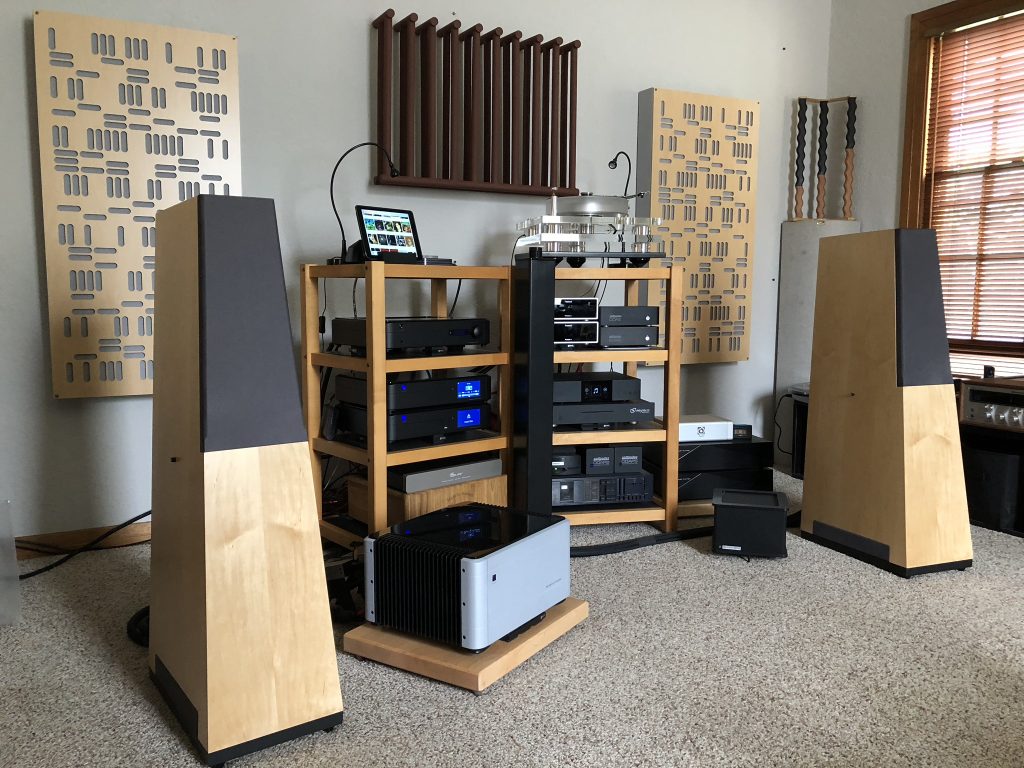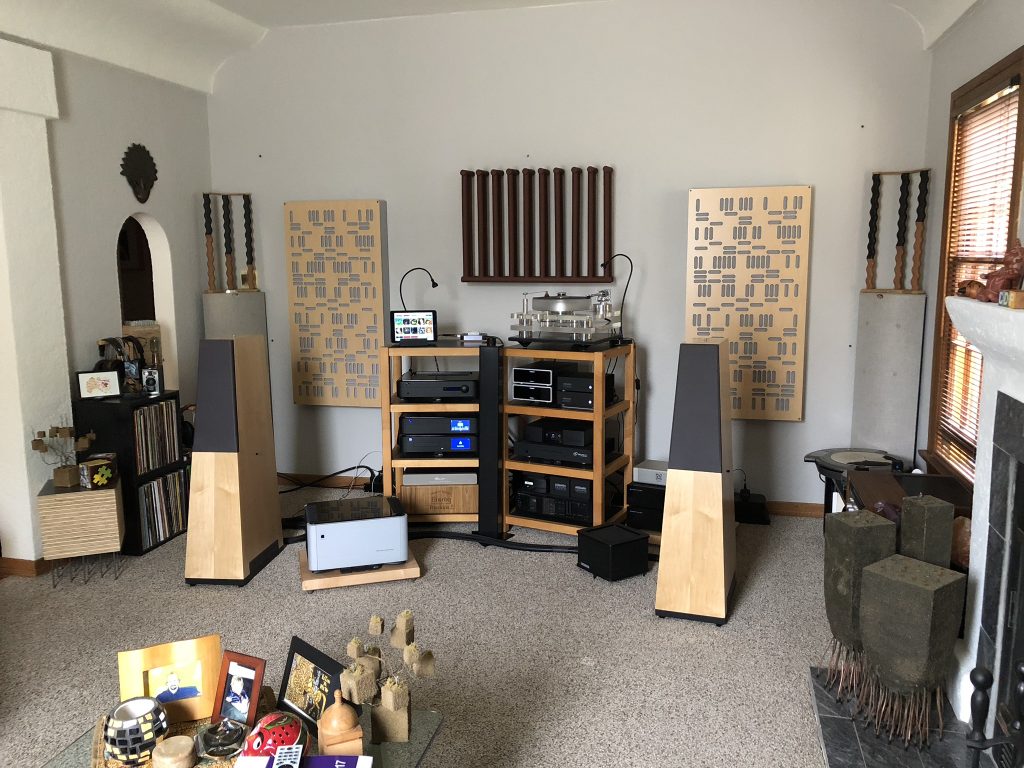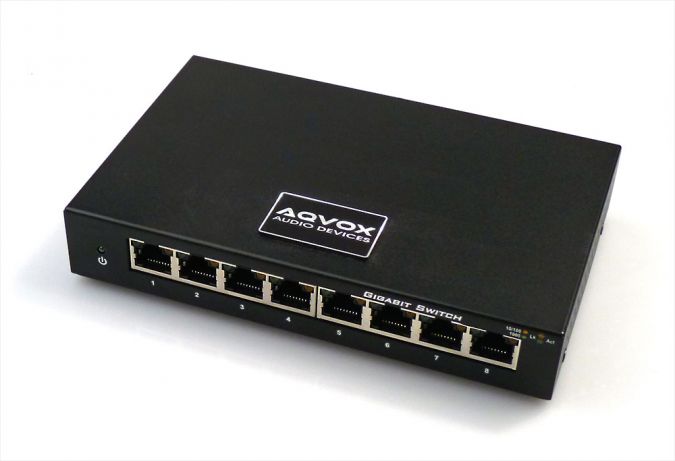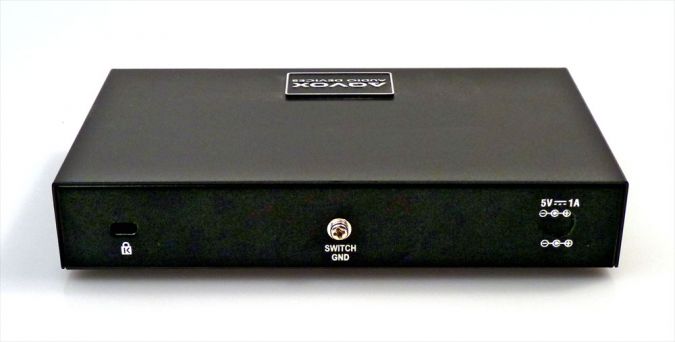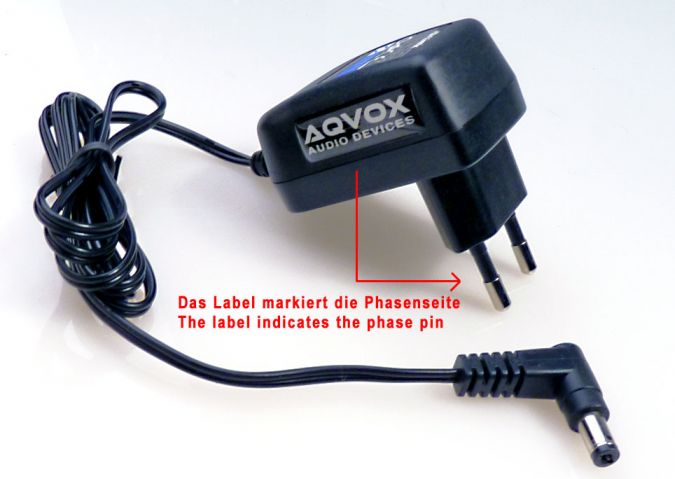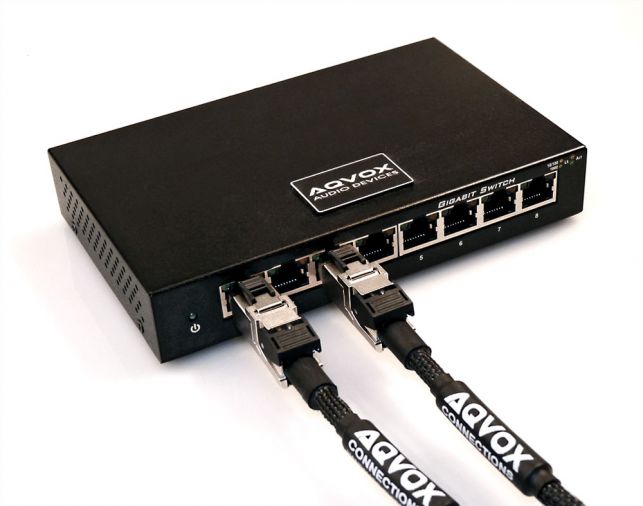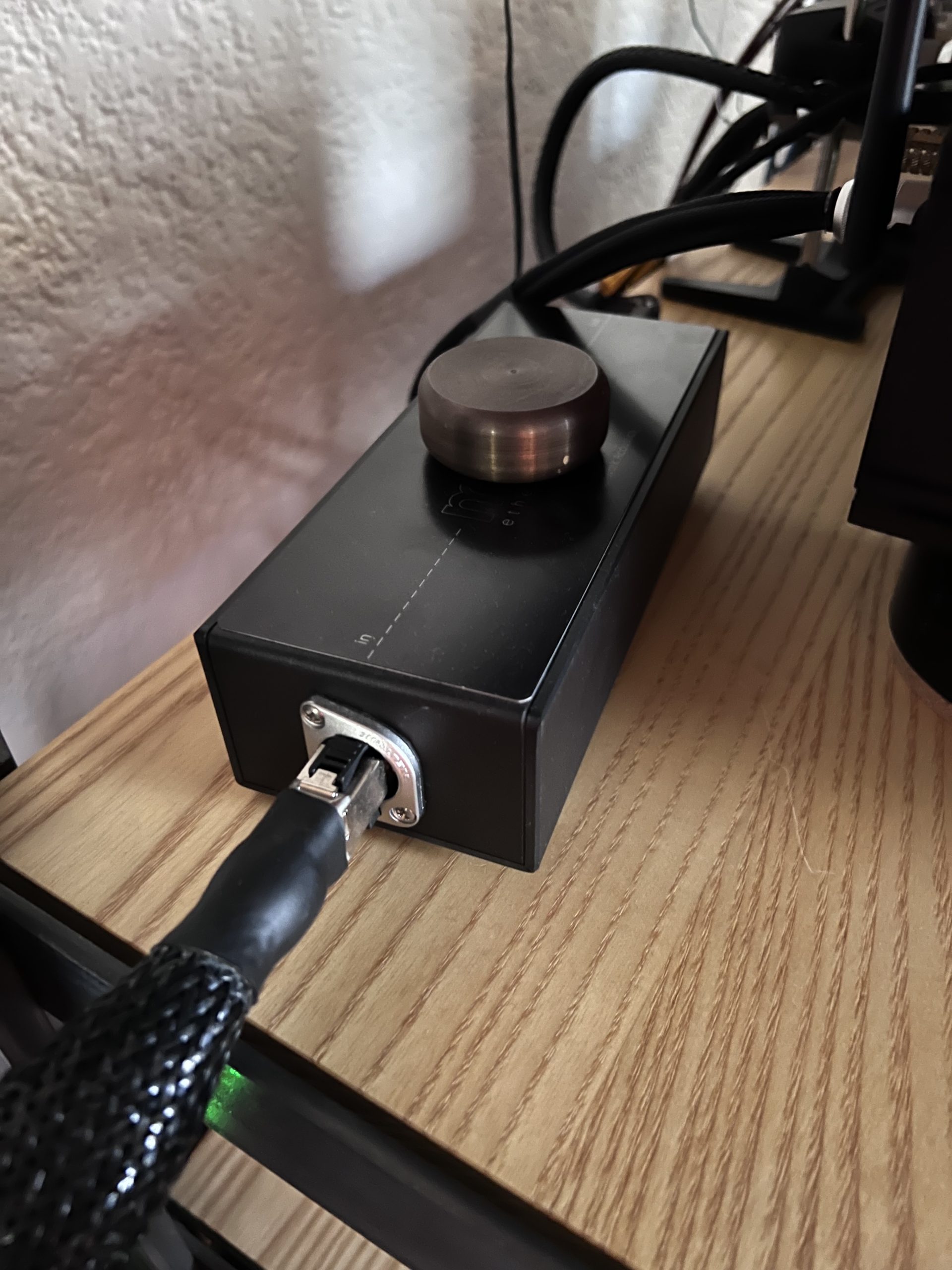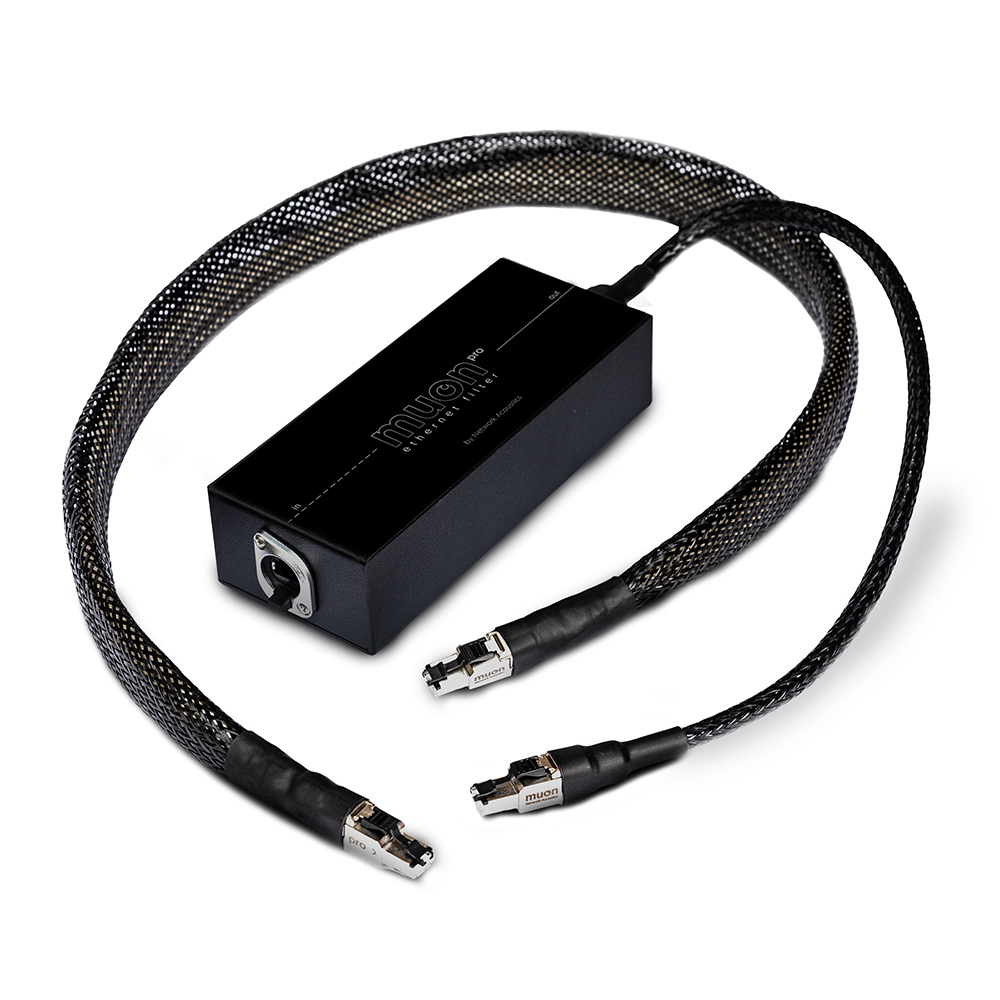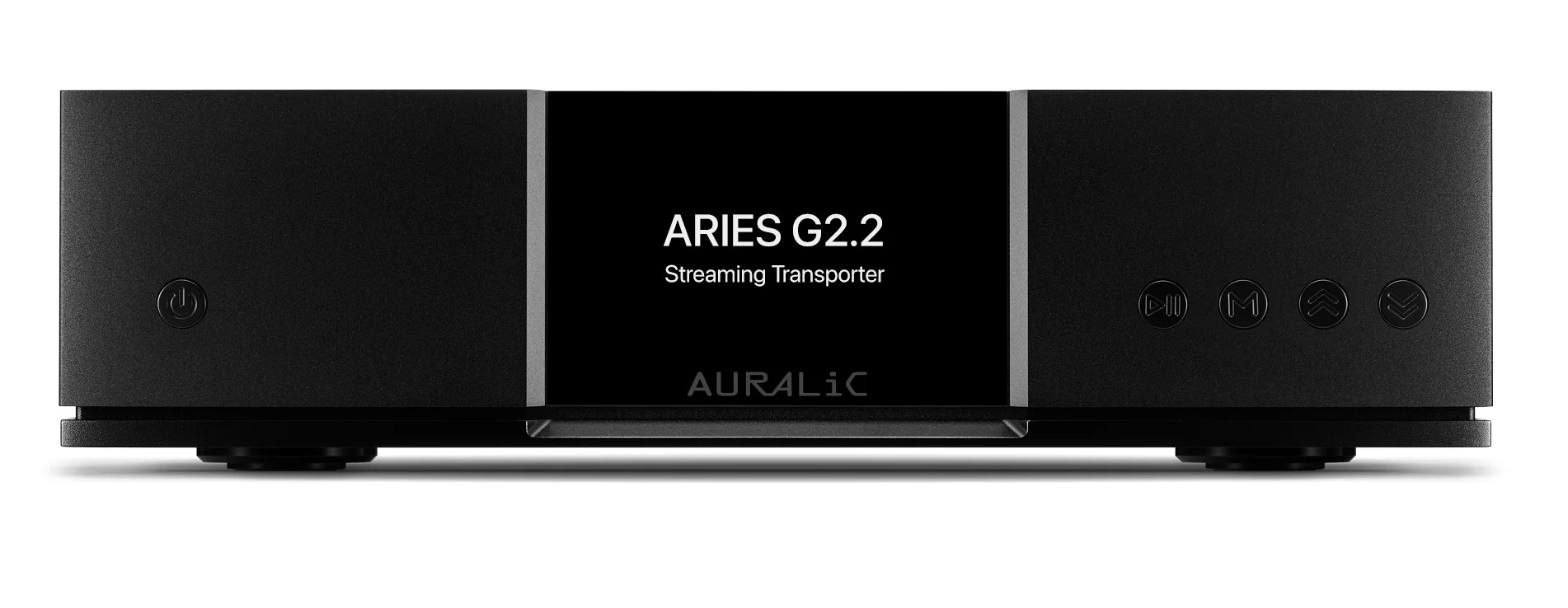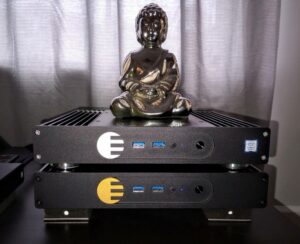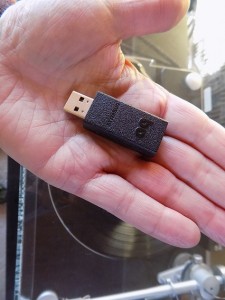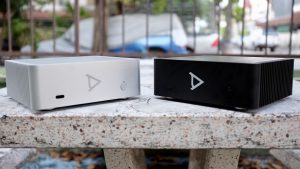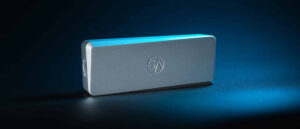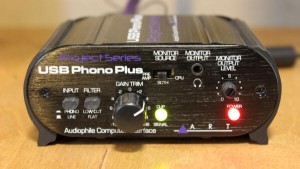All right, so I am a digital file playback guy and I admit it. My confession. I apologize and please forgive me for my regressions in audio… digital as opposed to analog. Oh screw that... digital is right fine, just different. For sure we buy as many LPs as we can, but truth is we hardly play them even though when we do we prefer the sound of our LPs over that of the files of the same tracks being played back via our digital chain. Analog sounds warmer and bigger… digital not as much. Not that the digital sounds bad… no, far from the truth. It sounds really good, but then I am still in the pursuit of getting it to sound more like analog—of which I know it won't, and so no, I can't. Digital sounds like digital and analog sounds like analog, but can I make our digital sound even better than it already does? And I am told, and I agree, it already sounds damn good.
Alright so here are our two chains for playing back music…
Digital
- PS Audio DirectStream DAC with the network Bridge II option (used with the Antipodes units) and current software.
- PS Audio DirectStream memory Player with current software.
- AURALiC Aries G2 (Lightening DS software) with current software.
- Antipodes Core/Edge combo (Roon software).
- USB cabling is a matter of choice with the best from WyWires (Diamond), Skogrand (Beethoven), Purist Audio, and others to use as we feel at the moment.
- UpTone Audio Iso Regen and UltraCap LPS Cap power supply (in use, but not sold on it).
- Ethernet cabling from Cardas (Clear), Wireworld (Starlight8), and Sablon Audio.
- Power cords from Triode Wire Labs (American Digital) and Sablon Audio (Panatela).
- Integrita C4 NAS from Certon (files ripped or downloaded in various formats).
- Ripped files through a dedicated external "tweaked" DVD drive using dB Poweramp. CDs treated prior to ripping with a black pen (edge), cleaned as needed, and then a short stop on the Furutech RD-2.
- SBooster power supplies for the Netgear Gigabyte switch and Netgear WiFi extender.
- Three Acoustic Revive LAN isolators on the switch.
Analog
- Transrotor 25/25/60 Leonardo turntable with a Shelter 901 MC cartridge w/Marigo dot mounted to an Audiomod MK2 arm.
- Heed Thesis Phi phono stage with the Pi power supply.
- Power cords from Triode Wire Labs (American).
- Furutech CD/LP Demagnizter.
- Furutech Monza Clamp.
- Furutech Destat III.
- Stein "The Perfect Interface π [piː]" Carbon Signature mat.
Both "systems" are plugged into their own (digital or analog) Tweek Geek Dark Matter Stealths and then grounded to a TELOS Ground Conditioner.
Use of Black Raviolis (all boxes) and BDR cones and board (turntable) are also evident.
Click on my name is the byline for everything else here - BTW, that works for all our contributors.
Yeah, so not too shabby, but with digital where to go to improve? Can we improve? Can we make it better? Something not too costly as being retired educators and not selling much in the way of my art… well let's keep it sane. We love the components and the sorts we have here… so where is an obvious potential weak spot?
Oh… wait a minute. How about that Netgear switch? I hear that there are now various "audiophile grade" switches around that are claimed to be way better than any stock switch—even those with special power supplies like those from SBooster.
Okay, well I did have one here from The Linear Solution that looked promising, but the manufacturer wanted it back in a time frame that precluded me from having pretty much any time to actually listen to the unit… it looked cool and offered a lot via its description, but come on man… give me longer than a few weeks to try it out... if it needs a few weeks to even break in! Especially at Christmas time when like... there are others things to do that preclude reviewing gear.
So along comes AQVOX out of Germany. Hummmm, this looks interesting. A good deal of similarities to the unit from Linear Solution, but … uh, but AQVOX is pretty much saying that what they are doing, and that this way is the only way to go… and get this, they explain why too. Cool. What they sent me is the SE version… the AQ-SWITCH SE Special Edition as opposed to the base model.
From their site…" We do not use the D-Link Switch as a base because it sounds better than other switches. The D-Link sounds just as bad as other models. We use the D-Link because our modifications are especially easy to implement here. To all who think the unmodified D-Link is a good choice—it is not. Even a sophisticated power supply just helps a little, compared to the huge effect of our modifications. And if you have a good NAS source like a Melco, the unmodified D-Link even degrades the sound quality."
Additionally, AQVOX goes on to offer more about their switch….
- Internal Ultra-Low-Noise voltage regulation
- Jitter Reduction
- ReClocker
- Signal Shaper
- EMI Eliminator
- De-Noiser
- Modified/optimized external power supply. The enclosed power supply is optimally matched to the High-End Switch. Other, supposedly better power supplies, including The AQVOX Low-Noise power supply have a deteriorating effect to the sound.
- By using components from the audiophile technology in the power supply, plus innovative noise suppression concepts, AQVOX has achieved a quantum leap in the improvement of signal quality during the transmission of digital media data. The data packets experience a precise re-alignment. Sound and picture deteriorating noise (EMI), induced by sources such as PC, NAS, routers, and as well power cables, are largely eliminated.
- In the SE version, we have integrated our newly developed phase correction, which has been applied for the first time in the AQVOX USB Detoxer QL 2, which has contributed to more space and improved definition and impulse fidelity.
- The new, optimized oscillator, which we refined with a tuning, is a factor 10 more precise clock generator. More precise focus and definition is the benefit.
- We have optimized the peripheral circuitry of the switch controller chip with additional interference suppression components. A plus of room information.
- The internal power supply circuits are now carefully optimized with additional Ultra-Fast capacitors.
- The lining of the metal housing with butyl rubber and thereby silenced also contributed to the sound improvement. A more black background.
- We have also been able to optimize the power supply even further.
Okay, for a number of you out there some of this sounds potentially questionable in terms of it being done to a switch and having any audible difference, and some of it sounds, well it sounds like sure, lets go with this and give it a try. Better power supply? Makes sense, I was doing that with the SBooster. Less noise? Agreed, am thinking that the Acoustic Revive LAN Isolators were all about that and the AQVOX appears to offer that through several methods as noted. EMI eliminator? Okay, I was doing that with a number of Shakti Onlines on the Netgear. As to what one might consider questionable… no idea really. Either the AQVOX SE makes a positive difference or it does not…. and if it does, well I would hope that what is being offered by AQVOX is what is making that happen. I am not a tech guy… nor a network person, so I am not going to go there, that I will leave up to those that are… all I can do is offer what the manufacturer claims and then what I heard. So, don't shoot the messenger.
So, in goes the AQVOX SE unit—they suggest a few days to settle in and yes, it needs to see some data to do that—and out goes the Netgear Gigabit switch. Now the issue is even though they are both there and on, swapping Ethernet cables in and out to do a quick A/B is not so easy… both the AURALiC, the Antipodes units, and Certon needed to reboot to regain their respective addresses… so it was pretty much a clean swap—one for the other, and then wait a few minutes for everything to settle back in. A pain, but then that is what it was…. I was not willing to go back and forth, back and forth, back and forth, back and forth. So, listen to one and then swap in one for the other… days go by and repeat as needed or as wanted. I mean I have been listening to my set-up for over a year now… I am pretty in tune with what it is doing to my music. Swapping in the AQVOX was pretty obvious as to any differences I heard.
Before I go into what I heard, and yes there was a difference between the tweaked Netgear Gigabit switch and the AQVOX switch… a couple of interesting observations.
One, the Acoustic Revive LAN Isolators would not work with the AQVOX producing a red light (no signal), but worked fine with the Netgear Gigabit switch. The people at AQVOX told me that they are already offering similar isolation (solution) inside the switch and so the LAN units are rather superfluous. But since they did not work anyhow… does not really matter. In an email they did try a LAN Isolator and found that while it did help in some ways, it hurt the sound in too many others … so, well that was a no go.
Two, prior to using the AQVOX, the fastest I could transfer ripped files from my PC to the Certon was a slow meager 10MBps. This requires going through a switch here in the office and out to the living room to the other switch there some 20 feet away—all through Audioquest Diamond Ethernet cables. Oddly going to the backup NAS here, and while the pathway is quite similar (minus the second switch in the listening room), transfer speeds are 80-100MBps—screaming baby. Swapping in the AQVOX SE for the second Netgear Gigabit switch in the living room… oh my! Now I am at 80-100MBps too!
Okay so what was the bottle neck? The switch or the LAN units? Not sure, but using the LAN units did improve the sound on the Netgear Gigabit switch, and I never noticed any degradation in the music if they were limiting transfer speeds of the files to where ever. So uh... yeah.
Three, the cable from the SBooster never really fit all that tightly into the Netgear switch making it somewhat of an issue if I did not pay attention to "harnessing" it somehow so it would not unplug. Plus, the SBooster required another AC cord and was a second box on the shelf. No big deal as I cannot recommend SBooster power supplies enough—they work and are a major step up from some wall wart. But still, it was a complex solution.
Okay, so what did I hear? Well, you obviously already know that if I am writing this, then yes it was an improvement. A clear difference in terms of ease and less "noise." The music flowed better and the lack of noise—not an audible noise, but a noise that can get in the way of the music or signal resulting in less… music—allowed more music to get through. What I mean is air, presence, space… all seemed larger or more realized. Little things were easier to decipher… they simply stood out more from (within) the music. Greater texture and feeling to the music. This was way nice. Now since it was not a quick swap, this took a while to discern and come to appreciate. For sure after extended periods of listening to tracks I am quite familiar with… yeah, this is better. There's more here. More that is quite appealing to what I want to hear from my music. Heck, even the bass was better—deeper with more punch and texture.
But the AQVOX SE is not going to makes things warmer, richer, leaner… or whatever. As I said, what it will do is allow more to get through… and as such more space… more there-ness. Meaning that the AQVOX SE does not have a sound, or will change the sound… in terms of tonality. It just lets more music through. More information.
For me it has always been about how to mitigate noise or whatever that can ride along in the signal or components and muck things up. Prior to the AQVOX, I thought that how I had the chain configured was the best I could obtain… SBooster, LAN Isolators, Shakti Onlines. Uh, yeah… no. The AQVOX SE takes the digital chain to a whole other level. Is what AQVOX SE is offering, or claiming, questionable in terms of what they have done to the D-Link switch? Proof is in the pudding… and our music sounds better in every way I would want… and can hear.
An interesting comment that the folks at AQVOX offer… "Some customers prefer 1-in 8-out or 4-in 5-out. We are mostly on 1-in 2-out. The differences are very small." All right, so now I have to try that! Mine started out 1 in and 8 out… and then everything else is plugged into the remaining ports—so go figure.
Euro 815 which is around USD $945, inclusive of shipping. Two year guarantee. AQVOX gives 30 days money back.
Sold.
Oh, and yeah... I get it. The D-Link can be bought online for like $30. Add in shipping and tax and say $40. How can AQVOX sell this for $950? A 24 times mark-up?! Dude are you insane?! Maybe, but then that is a different column so check back later. Look, they have done extensive modifications, all requiring extensive time and research into what to do and how to do it... meaning their time is worth what they choose it to be, and parts and materials cost something—packaging, etc. There is cost to do business and that is passed to the customer. In the end, either you accept it and buy the unit, have a listen and agree that it works, and is worth the cost, or you don't. If I were to price the Netgear ($45), SBooster ($375), Acoustic Revive LAN Isolators (three at $300 each is $900 total)... uh yeah at $1500 with the Shakti Onlines... the AQVOX SE is a bargain. I want to say that the older chain, with the Netgear and all, was doing what it could do, what I thought was the best one could get... all the things I did in the chain, did improve our music, but clearly not to the level of what the AQVOX SE can do, and is doing. The AQVOX SE is highly recommended.
Oh wait... I forgot there is a ground post on the unit. Hmmm, I wonder if I were to connect it to either Telos or the Entreq would there be a....




